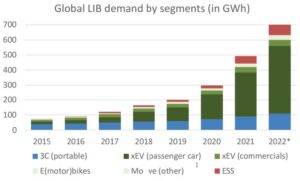The globally and fast increasing demand for battery electric energy storage systems in all areas, from consumer goods over electric mobility to stationary energy storage systems, requires customised concepts, both in terms of the battery system and its control. To this end, the NEXTBMS project is developing new solutions that facilitate the efficient and durable use of batteries with the view to improve their performance both
- in the mobile sector, i.e. by phasing out the use of fossil fuels for vehicles and moving towards electrification, and
- in stationary applications such as grid balancing and storage of energy from variable renewable sources (e.g. wind or solar energy)
as an enabling European activity.

*VDMA Roadmap: Lithium Ion Battery (LIB) production equipment 2030, update 2023
The aspect of an entire sustainable lifecycle for batteries is supported by NEXTBMS. One example for it is the combination of different use case within begin of life until end of life. So mobile use in 1st life can be combined with a less challenging stationary use case in 2nd life. Finally, also recycling indications can be given for an efficient re-use of battery material in the end.
The focus is on current and future battery-electric mobile and stationary applications, on the basis of which requirements regarding
- Lifetime (cyclic and calendar)
- Battery chemistry – materials and composition
- Challenging use case related electric loads
- Hardware – to bring up improved sensor concepts with the aim of achieving higher accuracy of measured variables
- Software – generation of improved battery models with the aim of achieving a higher accuracy of calculated variables and states for the battery management system (BMS)
to achieve higher vehicle range or operating hours and a longer, reliable battery service life.
Thus, the NEXTBMS project will also contribute to minimize climate change, e.g. by reducing CO2 emissions by extending battery life and efficient operation through more advanced BMS functions. Which also means a better utilisation of energy and raw materials, needed for battery production.
Click here to read the whole document.


